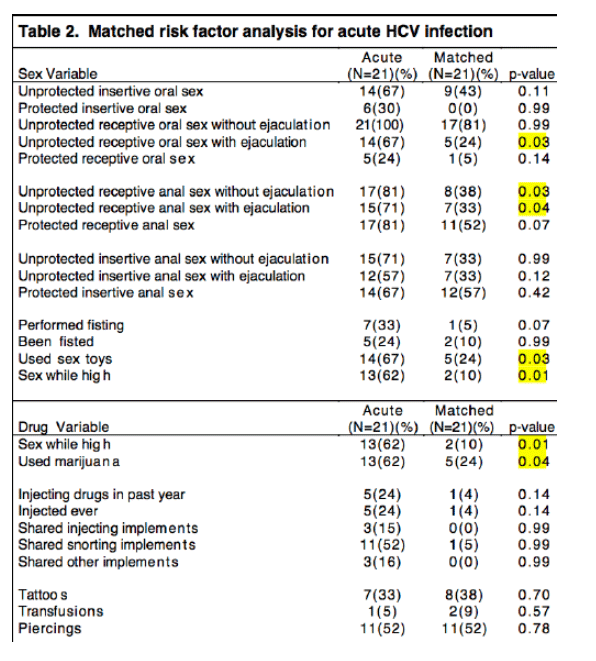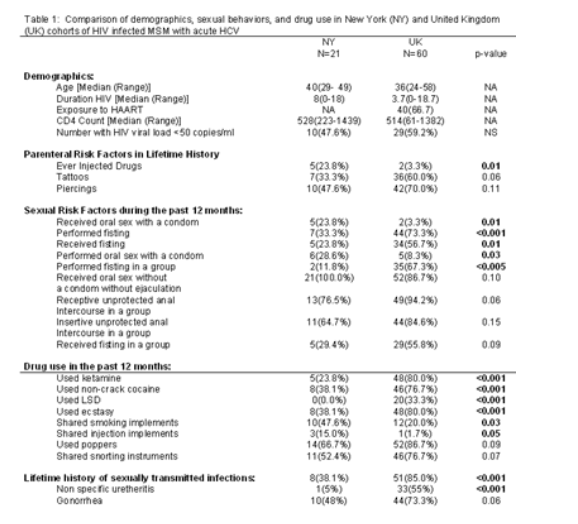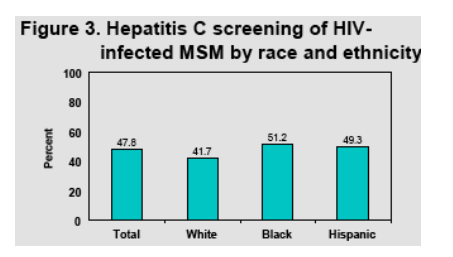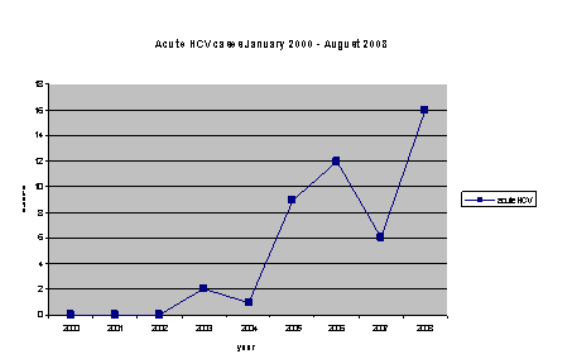 |
 |
 |
| |
Epidemic of Acute HCV Among MSM in Europe and New York City
|
| |
| |
Jules Levin
CROI 2009 Feb 8-12, 2009 Montreal
There were several posters at CROI reporting studies of acute HCV among MSM in New York City and in Western Europe in the UK, Amsterdam, and France. I spoke with a clinician at CROI from San Francisco who described to me a similar increase in acute HCV among MSM and among heterosexual women he sees at his clinic. I have spoken with many clinicians in NYC who tell me of numerous heterosexual women who are contracting HCV and acute HCV. Although this problem gets very little attention in the USA and is often dismissed because researchers don't think HIV+ women can get HCV sexually, I think this is real. There are several reasons including that the presence of HIV & STDs and anal sex can increase risk for sexual transmission, and several studies among women with HIV have reported this finding. The outbreak in Western Europe has been better characterized and it has been reported by researchers there that there is a network in major European cities where similar strains of HCV have been transmitted and unsafe sex practices and drug use are the cause as well as STDs. Of note, the group at Mt Sinai Hospital in NYC have reported at this CROI and at several previous conferences that acute HCV in patients already HIV-infected results in more advanced fibrosis, and this is worrisome since HIV can accelerates HCV progression.
Characterization of an Outbreak of Acute HCV Infection in HIV-infected Men in New York City: "Acute HCV infection of HIV-infected MSM results in significant liver fibrosis"....."We therefore recommend at least quarterly ALT and yearly HCV testing for all HIV-infected MSM. Promotion of safe sex and decreased drug use is also warranted."
"Acquisition of HCV infection in the outbreak of acute HCV infection in HI-infected MSM in New York City is associated with receptive, unprotected sex and results in early and rapid progression of liver fibrosis"
Daniel Fierer*, S Fishman, A Uriel, D Carriero, S Factor, M Mullen, D Dieterich, S Thung, I Fiel, and A Branch
Mt Sinai Sch of Med, New York, NY, US
Background: Outbreaks of acute hepatitis C virus (HCV) infection in HIV-infected men-who-have-sex-with-men (MSM) have been described in Western Europe. We recently described liver fibrosis in an outbreak in New York City, but little else is known about outbreaks in the United States.
Methods: Acute HCV infection was defined as newly identified HCV antibody with either new alanine aminotransferase (ALT) elevation, >1 log fluctuation in HCV viral load, or high clinical suspicion. We enrolled HIV-infected MSM with acute HCV infection to evaluate rates of spontaneous clearance, treatment response, and liver histopathology. All treated patients received pegylated interferon and ribavirin (pegIFN+RBV). We also conducted an age-matched case-control study on a subset of patients to identify sexual and drug use risk factors for acute HCV infection using a questionnaire; analysis was performed using McNemar's test.
Results: _We enrolled 31 HIV-infected MSM with acute HCV infection. Median age was 41 years; median CD4 count was 527 cells/μL. Among these men, 4 (13%) spontaneously cleared infection. Of the 21 patients who initiated therapy, 12 have completed therapy and the 6-month post-treatment observation period for sustained virological response: 10 initiated therapy in the acute phase (elevated ALT, fluctuating viral load), 8 had sustained virological response, and 2 failed therapy; 2 patients initiated therapy just after the acute phase (falling ALT, viral load not fluctuating) and failed therapy; 20 patients agreed to liver biopsy, performed at a median of 4.0 months after first ALT elevation; 17 (85%) had stage 2 fibrosis (Scheuer, scale 0 to 4), 2 (10%) had stage 1, and 1 (5%) had stage 0. The case-control study of 21 matched pairs showed an increased risk of HCV infection with: unprotected receptive anal intercourse with (p = 0.04) or without (p = 0.03) ejaculation; unprotected receptive oral sex with ejaculation (p = 0.03); use of sex toys (p = 0.03); "sex while high" (p = 0.01); and use of marijuana (p = 0.04).
Conclusions: Acute HCV infection of HIV-infected MSM results in significant liver fibrosis. Treatment is highly successful when initiated in the acute phase, but may be less successful if initiated months later. Thus, it is crucial to detect HCV infection in the acute phase to allow successful treatment and to prevent further progression of the already significant liver fibrosis. We therefore recommend at least quarterly ALT and yearly HCV testing for all HIV-infected MSM. Promotion of safe sex and decreased drug use is also warranted.

Evidence for Ongoing Epidemic Sexual Transmission of HCV (2006 to 2007) among HIV-1-infected Men who Have Sex with Men: France- "ongoing epidemic transmission of genotype 4d virus in the Parisian area"
Jade Ghosn*1,2, C Larsen3, L Piroth4, X Duval5, I Auperin6, E Delarocque-Astagneau3, A Gervais6, L Alric7, S Pol8, and M-L Chaix2
1Bicetre Hospital, Kremlin-Bicetre, France; 2Ctr Hosp Univ Necker, Paris, France; 3National Institute for Public Health, Saint-Maurice, France; 4Univ Hosp, Dijon, France; 5Hosp Bichat, Paris, France; 6Saint-Joseph Hospital, Paris, France; 7University Hospital, Toulouse, France; and 8Hosp Cochin, Paris, France
Background: An increase in sexually transmitted hepatitis C virus (HCV) among HIV-1-infected men who have sex with men (MSM) has been reported since 2000. The French National Institute for Public Health Surveillance conducted a national survey in 2006 to 2007 to describe the characteristics of acute HCV infection among HIV-1-infected MSM.
Methods: A sampling frame of 115 medical wards was constructed according to the number of HIV and AIDS cases in MSM reported to the National HIV surveillance system. Acute HCV was defined as a positive HCV antibody or HCV polymerase chain reaction (PCR) within 1 year of a documented negative anti-HCV test. Data on clinical and biological status of acute HCV and HIV infection were collected after consent and frozen plasma samples were centralized to sequence HCV-NS5b region for phylogenetic analysis purpose.
Results: _At the end of the survey, 32 of the 94 cases meeting the definition of acute HCV had complete clinical, biological, and sequencing data. Median age at HCV diagnosis was 40.5 years (range 31 to 58). Median time between HIV and HCV diagnosis was 10 years (range 0 to 22); 24 patients were receiving combined ART; 22 had undetectable HIV viremia and 27 had CD4 cell count above 350/mm3. __Acute HCV was diagnosed because of elevated transaminases on routine HIV biological follow-up for 27 patients, because of jaundice for 3 (other reasons for 2). __Concomitant sexually transmitted infection was present at the time of acute HCV in 11 patients: syphilis (7), Chlamydiae rectititis (2), Lymphogranuloma venereum (2). Unprotected anal sex was reported in 24 patients (including highly at-risk sexual behaviour in 6 patients). __HCV genotypic distribution was as follows: 4d (16), 1a (14), 3a (1), 4a (1). Of 14 genotype 1a viruses, 10 segregated into 3 clusters (3, 3, and 4 viruses) and of 16 genotype 4d viruses, 15 segregated in only 1 cluster. Interestingly, these 15 genotype 4d viruses isolated in 2006 to 2007 clustered with 4d viruses isolated in the Parisian area in 2001 to 2003, suggesting ongoing sexual transmission of an epidemic genotype 4d HCV strain.
Conclusions: We show evidence for ongoing sexual transmission of HCV in HIV-infected MSM in France, with an ongoing epidemic transmission of genotype 4d virus in the Parisian area. Our results support the need for regular screening for HCV infection in HIV-infected MSM.
Age and Risky Behaviors of HIV-infected Men with Acute HCV Infection in New York City Are Similar, but Not Identical, to Those in a European Outbreak: differences between NY & UK- in NYC more injection drug use & sharing injection drug use, in UK more other types of recreational drug use like ecstasy, more risky sex behavior in UK
Sarah Fishman*, K Childs, D Dieterich, D Carriero, A Uriel, M Mullen, S Factor, D Fierer, and A Branch
Mt Sinai Sch of Med, New York, NY, US
Background: Risk factors for hepatitis C virus (HCV) transmission in HIV-infected men in the United Kingdom have been reported. We identified a cohort of HIV-infected men with acute HCV infection in New York (NY) and now compare demographics and risk factors in this group to those in the United Kingdom.
Methods: The Danta risk factor questionnaire was administered to 21 New York HIV-infected men with acute HCV infection (defined by a combination of HCV antibody seroconversion, new alanine aminotransferase [ALT] elevation, and HCV viral load fluctuations). Responses of NY cases were compared to published responses of 60 UK cases using c2 and Fisher's exact tests.
Results: _The men in both the NY and the UK outbreaks of acute HCV infection were older adults (see the table), with a median age of 40 years in NY (see figure) and 36 years in the UK. The youngest cases in NY and the UK were 29 and 24 years, respectively; the oldest cases were 49 and 58 years. __The median duration of HIV infection in NY cases was 8 years, and it was 3.7 years in UK cases. In both outbreaks, some men had been infected with HIV for <1 year when they contracted HCV. __The table shows behaviors that differed between the cohorts with a p-value <0.2. In both groups, parenteral exposures could not account for all cases of acute HCV. Lifetime history of injection drug use was more prevalent in the NY group (24% vs 3%, p = 0.01). __In the 12 months prior to enrollment, NY cases reported less fisting (both active and receptive) than UK cases. __Interestingly, NY cases reported significantly higher use of condoms while performing and receiving oral sex. __Ketamine (p <0.001), non-crack cocaine (p <0.001), LSD (p <0.001), and ecstasy (p <0.001) use were significantly higher in UK cases. In contrast, NY cases reported more sharing of drug-smoking implements (p = 0.03) and more sharing of injection implements (p = 0.05). A smaller percentage of the NY cases reported a lifetime history of sexually transmitted infections (38% vs 85%; p ≦0.001), in particular non-specific urethritis (p <0.001).
Conclusions: HCV transmission among HIV-infected men-who-have-sex-with-men is not the result of adolescent risk taking, rather transmission is occurring primarily in men over the age of 35 years. This demographic feature raises the possibility that older age may be a risk factor for sexual transmission of HCV, as previously reported. The greater use of non-injection recreational drugs in the UK cases was a notable finding.

Hepatitis Screening of HIV-infected Men Who Have Sex with Men: 8 US Clinics - Only 43% of men were tested for HAV, 33% for HBV, and 48% for HCV. "Hepatitis B screening rates were high
Hepatitis A and hepatitis C screening rates were suboptimal"
Karen Hoover*1, K Workowski1,2, S Follansbee3, B Gratzer4, B Hare5, B Johnston6, T Chorba1, and C Kent1
1CDC, Atlanta, GA, US; 2Emory Univ Sch of Med, Atlanta, GA, US; 3Kaiser Permanente, San Francisco, CA, US; 4Howard Brown Med Ctr, Chicago, IL, US; 5San Francisco Gen Hosp Med Ctr, CA, US; and 6St Vincent Catholic Med Ctr of New York, US
Background: Compared to those with hepatitis C (HCV) mono-infection, persons co-infected with HIV are more likely to develop progressive liver disease. Early diagnosis and treatment of hepatitis B (HBV) and HCV infection is important in the management of persons with HIV infection. Current HIV Medicine Association guidelines include recommendations for hepatitis A (HAV), HBV, and HCV screening and vaccination for hepatitis A and B. In addition, the Ryan White CARE Act requires grantees to screen for hepatitis A and B and to vaccinate when indicated. The objective of this study was to estimate the proportion of HIV-infected men who have sex with men (MSM) receiving care in 8 HIV clinics that were ever screened for HAV, HBV, and HCV infection.
Methods: We evaluated clinical services provided to HIV-infected MSM at 8 clinics in 6 US cities. Medical records of 1607 patients were abstracted; these patients had approximately 12,000 visits during 1998 to 2007. HAV, HBV, and HCV testing rates were estimated. A patient was considered to be tested for HAV, HBV, or HCV if their hepatitis screening status was documented in the chart and they had at least one medical visit with a provider. Screening rates were also estimated by race and ethnicity, and by clinic site.
Results: Only 43% of men were tested for HAV, and 48% for HCV. The proportion of patients screened varied significantly by clinic, ranging from 14 to 63% for HAV (p <0.0001), 5 to 44% for HBV (p <0.0001), and 32 to 68% for HCV (p <0.0001). Within each clinic, men were screened for HAV, HBV, and HCV inconsistently. For example, at 1 clinic the HAV screening rate was 51%, HBV 42%, and HCV 39%; at another clinic HAV was 26%, HBV 35%, and HCV 48%. HAV screening was significantly lower among Hispanic patients (37%) than among white patient (49%) or black patients (46%) (p = 0.0009). HBV and HCV screening did not vary significantly by race or ethnicity.
During 2006-2007, we evaluated clinical services provided to 1,607 HIV-infected MSM at eight clinics in six U.S. cities with historically high rates of HIV and syphilis among MSM: Atlanta, SF, NY, Miami, LA, Chicago. Interestingly less whites were screened, 41.7% vs 51% for Blacks & 49% for Hipanics.

Conclusions: HBV, HCV, and HAV screening was sub-optimal at all clinic sites. Screening for HBV and HAV infection and vaccination of susceptible persons are important preventive services in the management of HIV-infected persons. Screening for HBV and HCV infection and evaluation of those persons with chronic infection is important to identify those who require treatment and may be at risk for progressive liver disease. Structural interventions are needed to increase hepatitis screening rates.
Rapid Rise of Acute HCV Cases among HIV-1-infected Men Who Have Sex with Men, Amsterdam - "HCV has become a sexually transmitted disease in HIV-infected MSM. Efforts to contain this epidemic should be started rapidly"......"None of our patients had any of the classical risk factors for HCV infection such as intravenous drug use or blood-blood exposure in endemic countries"
Guido Van Den Berk*, W Blok, H Barends, R Regez, J Frissen, I Spijkerman, I Schouten, and K Brinkman
OLVG Hosp, Amsterdam, The Netherlands
Background: The OLVG hospital is an inner city hospital in Amsterdam currently caring for more than 1800 HIV-infected patients, mostly men who have sex with men (MSM) (77%). Over the last year, we were confronted with many cases of acute hepatitis C virus (HCV). In this study, we will describe this epidemic in more detail.
Methods: In our database, HIV-1-infected MSM patients were selected for a HCV infection identified between January 2000 and August 2008. Acute HCV was defined as a HCV seroconversion, marked increases in concentrations of liver enzymes, and exclusion of other causes of acute liver disease The files of selected patients were reviewed and wherever possible, the seroconversion intervals were shortened by measuring HCV serology or polymerase chain reactor (PCR) in blood samples stored previously.
Results: _A total of 46 cases of acute HCV were identified. No cases of acute HCV occurred between 2000 and 2002, 2 cases in 2003, 1 in 2004, 9 in 2005, 12 in 2006, 6 in 2007, and 14 cases between January and August 2008 (see figure).

Marked increases in serum transaminases were seen in 44 of 46 patients (96%); 72% (n = 33) showed a >5-fold increase, the other 24% (n = 11) a 2 to 5 times increase. The 2 patients without elevated liver enzymes, had a seroconversion interval <6 months and were tested because of recent sexual risk behaviour: 15 patients (33%) had a seroconversion interval <6 months, 12 (26%) between 6 months and 1 year, 6 (13%) between 1 and 2 years, and 9 (20%) >2 years. In 9% (n = 4) the seroconversion interval remained unknown. In 42 of cases (91%) the HCV genotype was determined: 32 (76%) had genotype 1, 1 (2.4%) genotype 2, 1 (2.4%) genotype 3, and 8 (19%) genotype 4. None of our patients had any of the classical risk factors for HCV infection such as intravenous drug use or blood-blood exposure in endemic countries.
Conclusions: Our study confirmed a marked increase in the occurrence of acute HCV starting from 2003, escalating in 2008, and mostly involving HCV genotypes with a poor response to therapy. In the absence of classical risk factors, HCV has become a sexually transmitted disease in HIV-infected MSM. Efforts to contain this epidemic should be started rapidly.
|
| |
|
 |
 |
|
|